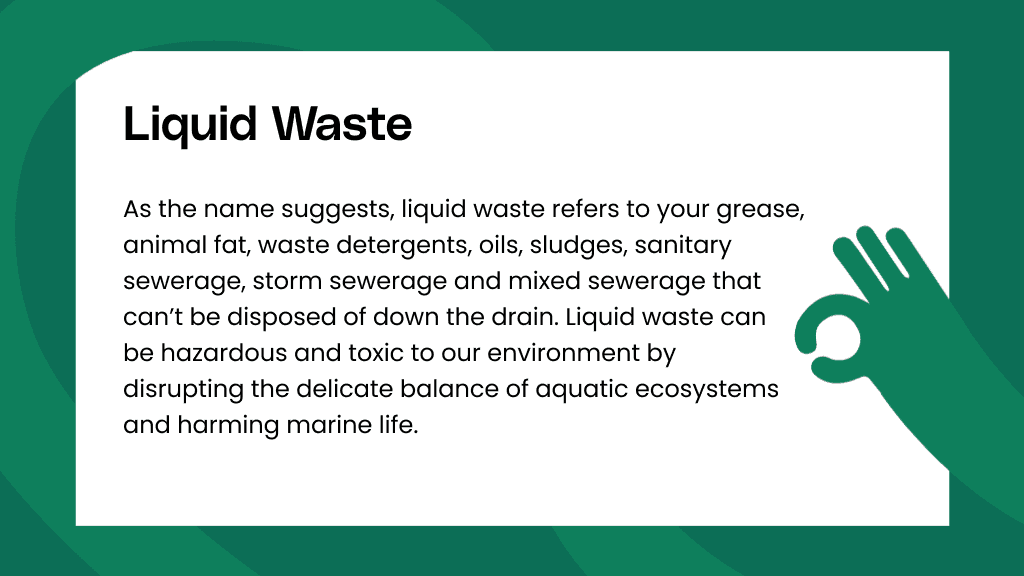Reclaim Waste for Dummies
Reclaim Waste for Dummies
Blog Article
9 Easy Facts About Reclaim Waste Explained
Table of ContentsThe Only Guide to Reclaim WasteReclaim Waste Things To Know Before You Get ThisReclaim Waste - TruthsThe smart Trick of Reclaim Waste That Nobody is Talking AboutReclaim Waste for Dummies
Check out the types, events, and types of liquid waste. Domestic sewer waste refers to the waste and items from a domestic septic system. This type of waste is produced by humans in houses, colleges, and other structures. This only includes sewage-disposal tanks that have a drainpipe field. The correct management and disposal of residential sewer waste require liquid waste to be moved to a sewage treatment plant where the appropriate techniques and devices are used to detoxify and get rid of waste.
Business waste typically includes possible risks, such as combustible products or a combination of liquid and solid waste items, and needs an advanced and thorough disposal process. The disposal of business waste usually entails the purification of waste prior to transport to ensure risk-free and proper disposal. Industrial waste is produced from byproducts and runoff of industrial processes and production.
This type of waste can not utilize the exact same sewer monitoring transportation or processes as septic or business fluids. The hazardous waste administration process calls for the inspection and testing of liquid waste before it goes through the disposal process (liquid waste removal melbourne). Overflow waste is the liquid waste that originates from runoff and excess stormwater in highly booming locations or cities
Drainage waste can create contamination and flooding otherwise taken care of properly. Find out more concerning drain cleaning and waste management. Guaranteeing appropriate waste administration can protect against catastrophes and decrease environmental harm. Both people in household settings and professionals in commercial or manufacturing markets can benefit from understanding the procedures and laws of fluid waste management.
Reclaim Waste Can Be Fun For Everyone
Contact PROS Providers today to learn more about our waste management and disposal solutions and the proper methods to care for the fluid waste you create.
(http://www.askmap.net/location/7161699/australia/reclaim-waste)This so-called 'wastewater' is not just an important resource however, after therapy, will be launched to our land, waterways or the ocean. Made use of water from bathrooms, showers, bathrooms, kitchen sinks, laundries and commercial processes is understood as wastewater.

water utilized to cool down machinery or tidy plant and equipment). Stormwater, a type of wastewater, is overflow that streams from agricultural and urban locations such as roofs, parks, yards, roads, courses and gutters right into stormwater drains pipes, after rain. Stormwater moves unattended straight to local creeks or rivers, ultimately getting to the sea.
Our Reclaim Waste Statements
In Queensland, many wastewater is treated at sewage treatment plants. Wastewater is transferred from domestic or industrial sites via a system of sewers and pump terminals, recognized as sewage reticulation, to a sewer treatment plant.
The Division of Natural Resources suggests city governments concerning handling, operating and maintaining sewerage systems and therapy plants. In unsewered locations, regional federal governments may call for householders to install specific or family sewage treatment systems to deal with domestic wastewater from toilets, kitchens, bathrooms and washings. The Division of Natural Resources authorizes using household systems when they visite site are proven to be effective.
In some new communities, therapy of some stormwater to eliminate clutter, sand and crushed rock has started using gross contaminant traps. Wastewater treatment takes place in 4 stages: Eliminates strong matter.
Wastewater then streams right into big containers where solids work out and are gotten rid of as sludge. Oil and residue are skimmed from the surface area. Uses small living microorganisms knows as micro-organisms to damage down and get rid of staying liquified wastes and fine bits. Micro-organisms and wastes are integrated in the sludge. Removes nitrogen and phosphorus nutrients that could trigger algal blossoms in our waterways and endanger marine life.
Reclaim Waste Things To Know Before You Get This
Nutrient removal is not offered at all sewage treatment plants since it needs costly specialised equipment. Clear fluid effluent created after treatment might still consist of disease-causing micro-organisms - liquid waste removal.

This generally suggests wastewater has to be treated or impurities gotten rid of before it can be discharged to rivers. A lot of wastewater streams into the sewerage system. Under the Act, city governments carry out authorizations and licences for environmentally pertinent activities (ERAs) entailing wastewater releases that may have a neighborhood impact. The division provides approvals and permits to Ages involving wastewater launches that may have a local or statewide effect.
Getting The Reclaim Waste To Work
Or else, examples are taken for research laboratory evaluation. Frequently numerous examinations are required to establish the levels of each of the different toxins such as oils, heavy metals and pesticides in water. Monitoring supplies valid details regarding water top quality and can validate that permit conditions are being satisfied. The info acquired with surveillance provides the basis for making water quality decisions.
Report this page